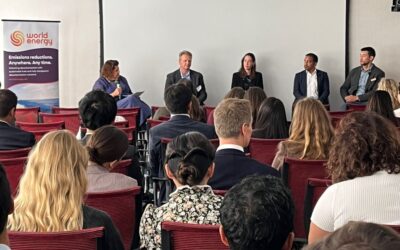Accelerating Sustainable Aviation and Beyond
World Energy is honored to coauthor RMI’s new Blueprints for Bankability report along with Microsoft
To date, banks have had a limited role in funding infrastructure to decarbonize industries like aviation. This report offers financial institutions, climate leading corporations, and renewable fuel producers a tool to expedite the contracting process and secure debt on more favorable terms.
All parties have something to gain from these bankability resources. Financial institutions can now streamline due diligence for a company’s commercial contracts. Corporate buyers, who are focused on credible emission reduction, can prove that their purchases result in additional supply above the status quo. And producers benefit from both the increased willingness of creditworthy counter parties to sign long-term offtake agreements and the potential to secure lower-cost capital from banks.
So what makes a contract bankable? According to the Blueprint for Bankability there are three major elements:
- Creditworthy customers: Buyers with higher credit ratings reduce commercial risks for producers. For example, corporate customers, like technology firms, pharmaceutical companies and management consultants who can sign long-term offtake agreements for SAF’s environmental attributes, in general have much stronger credit compared with airlines because they earn much higher margins than can be secured from flying passengers.
- Economic additionality: Producers have limited options to build new plants if they have to self-finance, and this in turn leads to slower industry growth. With corporate contracts, producers can find the most creditworthy customers which helps to cover cost premiums that derisk the commercial offtake for a new facility. That same buyer can now report that the emissions reductions associated with SAF from a specific facility are only possible because the buyer signed a specific agreement.
- Essential provisions: Banks need proven technology. They often avoid first-of-a-kind (FOAK) facilities because they can’t predict actual costs or guarantee production will occur at commercial-scale. Additionally, contracts must be binding with provisions like “Take-or-Pay” that lock buyers and producers into mandated purchasing and go beyond conditional agreements like MOUs. And finally, contracts must address price volatility because government incentive value fluctuates, operational costs are dynamic as are feedstock inputs, and the value of commodities like fossil-based jet fuel rises and falls with the market. Effective cost management could include a contract-for-differences (CfD) model or risk sharing with individual cost factors.
This report is only the beginning. RMI is planning a series of blueprints for other hard-to-abate sectors. World Energy has also been working on a companion project with the Roundtable on Sustainable Biomaterials (RSB) that complements the RMI report with a template for third party certified “bankable” contracts. It will be available before the end of the year.
With these new resources, we’re confident that more bankable contracts will be signed, and banks will move from the sidelines and start moving capital into harder to abate industry solutions.
Read the full report here.



